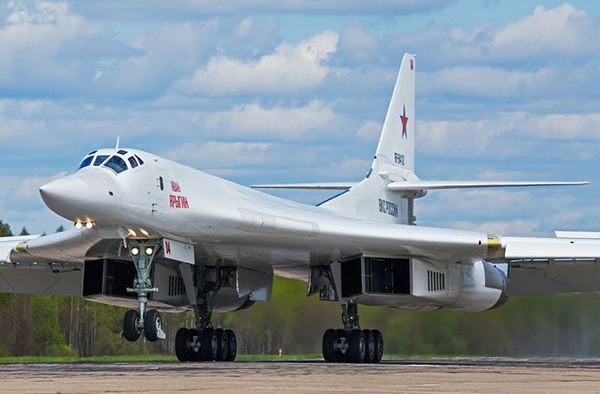The Indian Air Force seems to be getting over the strategic hump, perhaps with a little push from the PMO, and will soon acquire the advanced and upgraded version of the Tu-160 Blackjack called the ‘White Swan’. This transaction, after the S-400 and help in hypersonic weapons technology, confirms Russia’s status as the sole supplier to India of prime military technologies (even if for a hefty price!).
This was disclosed in a throwaway line about a “bomber” being acquired by IAF, which was preceded by a generous acknowledgement — “Mr Bharat Karnad will be happy to know”, by the former CAS, Air Chief Marshal Arup Raha. He was delivering the keynote speech, on 8 August, at the first edition of the ‘Chanakya Dialogues’ hosted by the Chanakya Foundation in New Delhi. On further questioning by me, he confirmed that the aircraft in question was the Tu-160.
By way of another casual remark, he also indicated that a nuclear-warheaded version of a hypersonic glide weapon may soon be on the way. No doubt it is an armament that will be carried in the White Swan’s weapons bay.
It will reverse the obdurately tactical and theatre-level orientation of the IAF brass for 70-odd years. It resulted in August 1971 in the IAF rejecting the Tu-22 Backfire bomber offered the Air Marshal Sheodev Singh Mission by the Soviet Defence Minister, the legendary Admiral of the Fleet, Sergei Gorshkov.
Moscow had not reckoned with the obstinately nonstrategic mindset of Air Chief Marshal PC Lal — regarded, incidentally, as a great leader by the IAF!– and his cohort running the service at the time. Indeed, Gorshkov was so certain the IAF would jump at this offer he had a squadron of this bomber aircraft painted with IAF roundels and parked on a military base outside Moscow for flight to India.
So what did IAF choose instead? MiG-23BN — no joke!! Worse, the IAF, dog-in-the-manger like, not only did not want the Backfire for itself, it later prevented the Indian Navy from buying this aircraft for maritime surveillance, fearing the Navy was trespassing on its turf by expropriating the strategic bombing role.
Post-1974 and India’s possessing very basic 12 kiloton gravity nuclear bombs, the Tu-22 would have been a credible recallable manned option as nuclear deterrent before India obtained in the late 1980s the first of the Agni land-based missiles. The Tu-22 could have been replaced with newer versions of the aircraft, including the latest, most advanced, Tu-22M3, and would now have comprised a more compelling two-pronged air vector in the nuclear triad along with the Tu-160.
It is always heartening when something one has ardently advocated over the years begins to take shape, becomes reality. The negotiations with Russia are apparently in the final stages for securing on lease six – a third of a squadron — better than nothing! of the supersonic, fly-by-wire, 4-man crewed Tu-160. It will leave the frontline Russian fleet with 29 of these aircraft, because only a total of 35 ‘White Swans’ have been built. Published material suggests the White Swan Tu-160 (the equivalent of the American B-1 strategic bomber) has a 70metres/second climb rate, max speed of 2,200 km/h and cruising speed of 960km/h, unrefueled range of 12,300km, and combat radius of 7,300km.
One version of the bomber runs on hydrogen fuel, which may be right up Prime Minister Narendra Modi’s plan for converting the country to a hydrogen economy. Though for reasons of fuel/fueling aspects, the aircraft India leases will likely stick with the variant run on enhanced aviation fuel.
To show off its astonishing endurance, the Russian Air Force staged a Murmansk to Venezuela sortie in 2008 (to show support for the regime of Left-leaning President Nicolás Maduro Moros at a time when the Obama Administration was tightening the sanctions screw on it), and in 2010 a 23 hour patrol covering 18,000 kms over the Russian landmass.
The options and possibilities this bomber offers should make the mouths of IAF warplanners and operations guys water. Preparatory planning should begin for nuclear targeting by the White Swans of the most distant Chinese targets — Beijing!, with the more critical, but relatively proximal, targets, such as the Three Gorges Dam and its system of downstream dams and the Lop Nor nuclear weapons complex in Xinjiang left, if necessary, for the Su-30MKIs to take out. The Sukhois can be embarked from Tezpur/Kalaikunda in the one case, and the Ainee base in Tajikistan available to IAF, in the other.
The problem IAF will have is in basing the Blackjack. The Bareilly base — which ran the Canberra medium bomber and the MiG-25 Foxbat high-altitude surveillance aircraft, won’t do. Bareilly is too near major and satellite PLAAF airfields on the Tibetan plateau in the central sector of the LAC, not to pose risks to the White Swans based there. A base in southern central India will be the safest and best option considering the “long-legged” Tu-160 will still be able to hit deep inside China, and have IAF air defence/interceptor aircraft out of a string of air bases in northern India as protective tier.


















